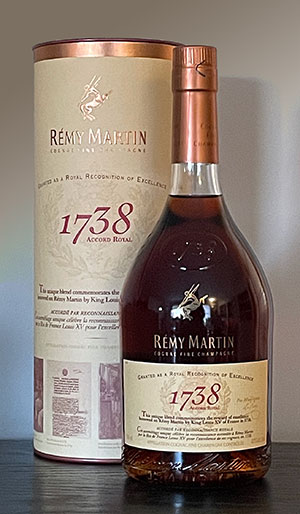
Rémy Martin is one of the world’s oldest and best known cognac brands, with selections that range, at my local liquor store at least, from the $13 St. Remy French brandy to the $9000 Rémy Martin Louis XIII Time Collection: City of Lights – 1900. (I have tried one of these, but not both.)
Rémy Martin was founded in 1724 in the Cognac region of France by Paul-Emile Rémy Martin. He was born in 1695 near Rouillac in southwestern France, the son of a vine grower. At 19, he married the daughter of a local notary, and 10 years later, in 1724, he established a cognac trading house. On his death in 1773, the business passed to his grandson, also named Rémy, who was also the local tax collector. In time, his son inherited the business, which saw a four-fold increase in the region’s trade between 1810 and the early 1820s. In 1841, Paul-Emile-Rémy Martin (the family gave just about every male heir the same name, apparently) assumed control and oversaw even greater growth. He introduced the innovation of selling in bottles as well as the traditional casks. An early skilled marketer, he added a logo to the bottles and cases; a centaur after Sagittarius, Martin’s zodiac sign, and registered the firm’s first trademarks in 1874. Following him, as so often happens in dynastic families, the fifth-generation proprietor nearly bankrupted the operation.
It was saved in 1927 by André Renaud, the son of a Grande Champagne grower, who was also a lawyer, a merchant, and who had been involved in E. Rémy Martin & Co. since 1910. He reduced quantity, increased quality, and applied the VSOP designation, an eighteenth century term for old cognacs. (VSOP, like VS and XO, are traditional terms that specify the age of the cognac, but not its quality.) By the time Renaud died in 1965, the company was selling 300,000 cases a year, and was the leader in the premium Cognac segment. Rémy Martin continued to rise under André Hériard-Dubreuil, André Renaud’s son-in-law. He constructed a modern production facility and introduced the now iconic frosted bottle for the VSOP in 1972. As they came of age, his children joined him, notably his daughter Dominique Hériard-Dubreuil who became general manager in 1988, and president two years later. In 1991, Rémy Martin acquired Cointreau.
Rémy Martin cognacs have the Cognac Fine Champagne appellation, meaning they come only from a blend of eaux-de-vie (literally waters of life, but translated as spirits) from the Grande Champagne and Petite Champagne crus, with at least 50% Grande Champagne. Being from chalky soils, these eaux-de-vie have ageing potential and a particular aroma due to the terroir. The Rémy Martin estate is a mere 494 acres, which, predictably, only supplys about three percent of their needs. For the rest, they contract with some 1,800 growers. Most of the base wine is made from Ugni Blanc, typical for cognacs, with some Collombard and Folle Blanche used as well. Production is done at four distilleries in the region. Methods include preheating the wine in a chauffe-vin (or wine warmer), after having ensured that the wine passes through its malolactic fermentation, and then distilling on the lees (sediment from grape fermentation) in small classic alembic charentais copper stills . Ageing takes place in Limousin oak barrels suppled by Rémy Martin’s own cooperage.
Rémy Martin is now one of the “big four” cognac houses (along with Hennessy, Courvoisier, and Martell), responsible for producing most of the world’s cognac. Rémy Martin itself sells around 2.2 million cases of cognac annually, more than 80% of Fine Champagne cognacs.
Sustainability
Sustainability has the biggest buzz in the wine world, and it is no different at Rémy Martin. In 2007 they made the decision to move towards fully sustainable agriculture. In 2012 they began working towards High Environmental Value (HVE) certification, a marker of agricultural excellence. All of their growing partners are now committed to sustainable agriculture, with 50% already HVE-certified.
THE SOILS AND THE TERROIR
For Rémy Martin, the terroir has three components: the soil, the vines, and the people working on the land, which are viewed as inextricably linked. As already mentioned, Rémy Martin farms in the Grande and Petite Champagne regions. The term ‘Champagne’ comes from the Latin word ‘Campania’, which is associated with limestone soils. The clay-limestone soils, combined with the limestone subsoils, require a vine’s roots to grow deep to absorb water and trace elements.
Rémy Martin 1738 Accord Royal Cognac
This product was launched in 1997, and is named after the royal decree issued in 1738 when King Louis XV granted the Accord Royal to Rémy Martin in honor of his craftsmanship (and to assure a steady supply of his cognac). It was illegal to plant new vines in France at the time, but the king is said to have loved Rémy Martin’s cognac so much that he granted permission—an accord royal— to do so.
This is a blend of eau-de-vies (another reviewer claimed 240, but that seems unlikely to me.) While technically a VSOP cognac (meaning the youngest eaux-de-vie in the blend are four years old), some of this is aged considerably longer, up to 20 years. It is deep reddish amber, which could reflect the age of the blend, or more likely, the fact that caramel coloring has been added, which is a fairly common practice in the world of cognac.
The nose offers up concentrated dark fruit, caramel, and a hint of roses. For a cognac with at least some decades-old portion in the blend, this is surprisingly fiery on the palate. There is plenty of black pepper and spice, plus hints of vanilla and brown sugar. It has a dry, medium body. The long finish, with a suggestion of oak and tobacco, lingers for some time after the last sip.
Top of page: https://winervana.com/blog/
